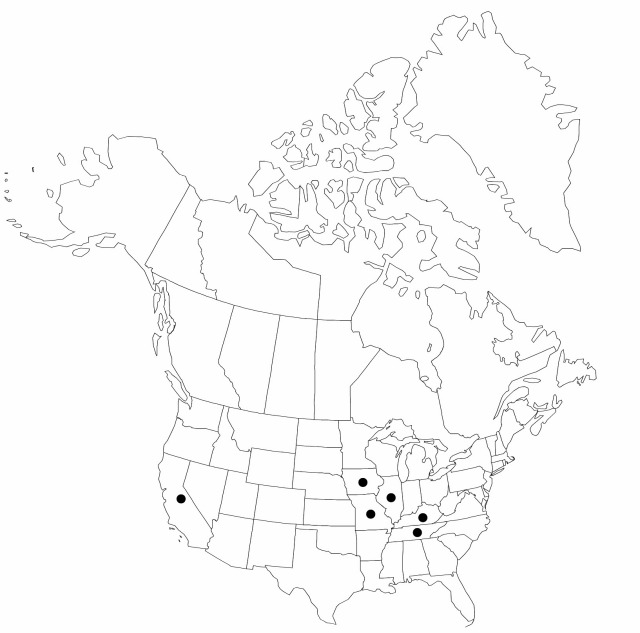Difference between revisions of "Schoenoplectus mucronatus"
Verh. K. K. Zool.-Bot. Ges. Wien 38(Sitzungsber.): 49. 1888.
FNA>Volume Importer |
FNA>Volume Importer |
||
| Line 27: | Line 27: | ||
|elevation=20–300 m | |elevation=20–300 m | ||
|distribution=Calif.;Ill.;Iowa;Ky.;Mo.;Tenn.;Eurasia;Africa;Australia. | |distribution=Calif.;Ill.;Iowa;Ky.;Mo.;Tenn.;Eurasia;Africa;Australia. | ||
| − | |discussion=<p>Schoenoplectus mucronatus was collected before 1900 in New Brunswick and New Jersey; apparently the plants did not persist. It has also been reported from New York and Pennsylvania; I have not seen specimens. Elsewhere, it has become firmly established. It is an important ricefield weed in California (M. K. Bellue 1947), where it was first observed in 1942 and is called “ricefield bulrush.” It was first observed in the Midwest in 1971. Schoenoplectus mucronatus is cultivated for wildlife food near the Columbia River in Clark County, Washington, but apparently is not established in that area. Schoenoplectus mucronatus is very similar to S. triangulatus (Roxburgh) Soják of Asia, which differs in its larger spikelets, spikelet scales, and anthers.</p> | + | |discussion=<p><i>Schoenoplectus mucronatus</i> was collected before 1900 in New Brunswick and New Jersey; apparently the plants did not persist. It has also been reported from New York and Pennsylvania; I have not seen specimens. Elsewhere, it has become firmly established. It is an important ricefield weed in California (M. K. Bellue 1947), where it was first observed in 1942 and is called “ricefield bulrush.” It was first observed in the Midwest in 1971. <i>Schoenoplectus mucronatus</i> is cultivated for wildlife food near the Columbia River in Clark County, Washington, but apparently is not established in that area. <i>Schoenoplectus mucronatus</i> is very similar to S. triangulatus (Roxburgh) Soják of Asia, which differs in its larger spikelets, spikelet scales, and anthers.</p> |
|tables= | |tables= | ||
|references= | |references= | ||
| Line 52: | Line 52: | ||
|publication year=1888 | |publication year=1888 | ||
|special status= | |special status= | ||
| − | |source xml=https://jpend@bitbucket.org/aafc-mbb/fna-data-curation.git/src/ | + | |source xml=https://jpend@bitbucket.org/aafc-mbb/fna-data-curation.git/src/8f726806613d60c220dc4493de13607dd3150896/coarse_grained_fna_xml/V23/V23_86.xml |
|genus=Schoenoplectus | |genus=Schoenoplectus | ||
|section=Schoenoplectus sect. Actaeogeton | |section=Schoenoplectus sect. Actaeogeton | ||
Revision as of 17:11, 18 September 2019
Plants perennial (or annual?); rhizomes hard. Culms sharply trigonous, 0.4–1 m × 2–3 mm. Leaves 1–2; sheath fronts not pinnate-fibrillose; ligules absent; blades absent. Inflorescences capitate; proximal bract divergent to reflexed or rarely erect, trigonous, adaxially channeled, 1–10 cm. Spikelets 4–20, 7–12 × 4 mm; scales orange-brown to straw-colored, central region often greenish, broadly obovate, 3–3.5 × 2–2.5 mm, margins ciliolate, apex obtuse to broadly acute, entire, mucronate. Flowers: perianth members 6, brown, bristlelike, equaling achene, stout, retrorsely spinulose; anthers 0.8 mm; styles 3-fid (or some 2-fid in same spikelet). Achenes dark to blackish brown, thickly plano-convex to obtusely trigonous, broadly obovoid, 1.7–2.2(–2.5) × 1.2–1.7 mm; beak 0.2 mm.
Phenology: Fruiting summer–fall.
Habitat: Wet soil to emergent in fresh water, ponds, ditches, rice fields
Elevation: 20–300 m
Distribution

Calif., Ill., Iowa, Ky., Mo., Tenn., Eurasia, Africa, Australia.
Discussion
Schoenoplectus mucronatus was collected before 1900 in New Brunswick and New Jersey; apparently the plants did not persist. It has also been reported from New York and Pennsylvania; I have not seen specimens. Elsewhere, it has become firmly established. It is an important ricefield weed in California (M. K. Bellue 1947), where it was first observed in 1942 and is called “ricefield bulrush.” It was first observed in the Midwest in 1971. Schoenoplectus mucronatus is cultivated for wildlife food near the Columbia River in Clark County, Washington, but apparently is not established in that area. Schoenoplectus mucronatus is very similar to S. triangulatus (Roxburgh) Soják of Asia, which differs in its larger spikelets, spikelet scales, and anthers.
Selected References
None.
